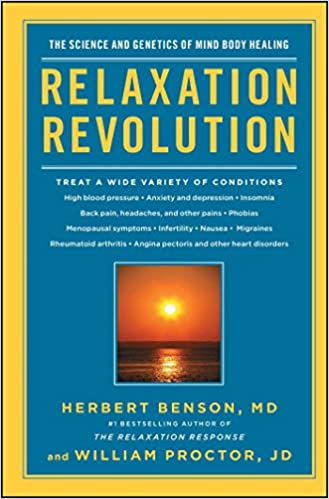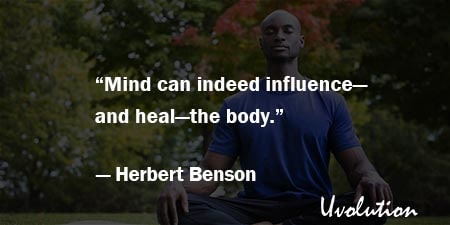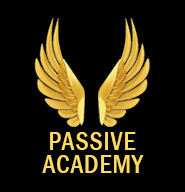Relaxation Revolution by Herbert Benson Summary
The Book in 1 Sentences
Relaxation Revolution: The Science and Genetics of Mind Body Healing
“Gradually, study after mind body study, carried out with the most careful scientific protocols, produced incontrovertible evidence that the mind can indeed influence—and heal—the body.” ~ Herbert Benson
9 BIG Ideas
2. Many Ways to Trigger The Relaxation Response
3. Two-phase Benson-Henry Protocol for mind body healing
4. Don’t worry about how well you’re doing!
5. Just say, ‘Oh well,’ and return to the exercise!
6. The Mind and The Body are One
Relaxation Revolution Book Summary
1. The Relaxation Response
“Briefly stated, the relaxation response is defined as the response that is the opposite of the
“fight-or-flight” or stress response.
It is characterized by the following: decreased metabolism, heart rate, blood pressure, and rate of breathing; a decrease or “calming” in brain activity; an increase in attention and decision-making functions of the brain; and changes in gene activity that are the opposite of those associated with stress.”
“We knew from our previous scientific studies that those practicing mind body techniques tended to experience lower blood pressure, calmer brain activity, healthful emissions of nitric oxide in the body’s cells, and other physical and emotional benefits.”
“We now have scientific proof that the mind can the body.”
2. Many Ways to Trigger The Relaxation Response
“The participants in the genetics study used a number of different meditative, relaxation, and prayer-based techniques. These included repeating a mantra, mindfulness meditation, Transcendental Meditation, Vipassana meditation, breath focus, Kripalu or Kundalini yoga, and repetitive prayer.
Despite the variety, all techniques yielded the same gene expression. We found that our minds and bodies, all the way down to the genetic level, are built to experience a common relaxation response state, regardless of the technique used to elicit it.”
“There is no single, correct approach for triggering the relaxation response or employing any other mind body technique.
For one person, a repetitive action, such as walking or jogging with a focus on regular footfalls, may be the answer; for another, a repetitive phrase or prayer, said silently or audibly, may provide the gateway to healthful inner physiologic and genetic changes; or for someone like Adam, an appropriate recording, such as the Olivia CD, may be the best approach.
But if you use one of these options, it is just as essential to include the three components listed on page 10 of the first chapter: 1) break the pattern of everyday thoughts; 2) assume a passive attitude; and 3) devote at least 12 to 15 minutes to the Phase One relaxation response trigger.”
Check out the book for the eight step process of inducing Benson’s relaxation response.
3. Two-phase Benson-Henry Protocol for mind body healing
“I introduced her to our two-phase Benson-Henry Protocol for mind body healing: 1) the Phase One relaxation response trigger, and 2) Phase Two visualization or mental imagery.”
The basic idea is to spend 12-15 minutes dropping into the relaxation response and then, while in that relaxed, receptive state, “use mental imagery, such as picturing a peaceful scene in which you are free of your medical condition, to engage healing expectation, belief, and memory.”
“The power of expectation—the kind of expectation that embraces a deep belief that what is expected will actually occur—has long been recognized as a significant mental and emotional force.”
4. Don’t worry about how well you’re doing!
“Here is a typical, simple response that I give to such performance-focused anxieties: “Don’t worry about how well you’re doing! Don’t worry about whether the relaxation response is really working or whether your mental picture is maximizing your health benefits. Just do it!”
I also frequently use the analogy of brushing teeth. Most of us are concerned to one extent or another with dental hygiene, but we don’t dwell on the tooth-cleaning process. We just work away with that brush every day. Almost no one evaluates the brushing, to say, “That was a good brush!” or, “Too bad—that was a bad brush.” We simply do it!
Similarly, if you’re taking a pill your doctor has prescribed for your cholesterol or blood pressure, you probably don’t wonder, “Am I putting this pill in the proper side of my mouth? Am I swallowing it correctly? Is it really going to work?” Again, you just do it—and that should be your approach to mind body treatments.”
5. Just say, ‘Oh well,’ and return to the exercise!
“As part of these review sessions, the researcher answered the participant’s questions, including those posed on the daily home logs. Probably the most common was some variation of this one from Adam: “I keep having these outside thoughts that interfere with my concentration—what can I do to avoid them?” The best answer: “Just say, ‘Oh well,’ and return to the exercise.””
“Emphasis was placed on the calming effects of regular, deep breathing; on the benefits of using a repetitive phrase or sound; and on the importance of passively ignoring intrusive thoughts.”
6. The Mind and The Body are One
“In fact, any condition that is caused or exacerbated by stress can be helped by a well-designed mind body approach. Furthermore, because all health conditions have some stress component, it is no overstatement to say that virtually every single health problem and disease can be improved with a mind body approach.”
An old-school philosopher named Plato was talking about the same idea 2,500 years ago: “The greatest mistake physicians make is that they attempt to cure the body without attempting to cure the mind; yet the mind and the body are one and should not be treated separately!”
“These studies have established clearly that eliciting the relaxation response through any of a wide variety of techniques will actually change the body’s gene activity or “expression.””
7. The Placebo Effect
“I knew that it was essential for Caroline to be convinced that this new concept to which I was introducing her—the use of mind body healing to control her pain—was rooted in scientific fact.
Many hundreds of scientific studies have shown that an inner conviction, which the medical community has linked to the phenomenon called “the placebo effect,” can help produce healing for scores of diseases and medical complaints.
The placebo effect is a mind body mechanism that may bring about healing through a person’s expectation and belief that a certain treatment will work.”
8. The Power of Expectations and Beliefs
“Scientific research now shows that the “miracles” of the self-healing powers of the mind and body are no less significant than the “miracles” wrought by many drug and surgery treatments.
These well-designed scientific studies make it clear that it is at least as reasonable to believe in the healing power of the mind as it is to believe in the healing power of a given drug or surgical procedure.”
“But is there any scientific foundation for placing expectation and belief on such a high pedestal?
More specifically and personally, just how powerful can your personal beliefs and expectations be in the healing process? Let’s allow a 2002 study in the New England Journal of Medicine to suggest an answer.
In this study, conducted by scientists at the Baylor College of Medicine, 165 patients with osteoarthritis (wear-and-tear arthritis) of the knee randomly received one of three treatments: arthroscopic debridement (removal of dead tissue inside the knee); arthroscopic lavage (washing-out of the knee joint); or placebo “sham” surgery.
Arthroscopy involves the use of a fiber-optic device that is inserted to permit observation of the inside of a joint and to facilitate surgical procedures inside the joint. In this investigation, the placebo surgery involved having a physician make a surface skin incision on the knee and simulate a debridement without insertion of an arthroscope.
The researchers assessed the outcomes of the procedures over a 24-month period. The results were startling: The investigators reported that at no point did the patients who had the real surgery have less knee pain or better physical function than the placebo group.
The sham surgery worked as well as the real surgery. The researchers concluded that there was no clinically meaningful difference among the three groups. In fact, they said, at some points during follow-up, objective physical function of the patients was significantly worse in the debridement group than in the placebo group!
This study is by no means an isolated example of the power of belief and expectation.
Hundreds of other investigations, involving a wide variety of diseases and health problems, have demonstrated the power of the human mind over disease. The treatment principle might be summed up this way: Just as an antibiotic drug may stop an infection or surgery may eliminate a malignancy, so the mind—your mind—has the capacity to treat or even cure many of your serious physical and emotional complaints.”
“You can restructure your thinking processes to expect good health rather than bad. With that expectation, your mind will more likely influence your body in a healthful direction.”
“The better you understand how these mind body clinical studies have improved hypertension, chronic pain, depression, angina pectoris, and many other health conditions and complaints, the more clearly you will see how these findings can be applied to treat your medical problems.”
9. Effect of Relaxation on Our Gene Expression
“We continued our investigation by posing these questions: “What would happen if the participants in Adam’s group—those with no experience with the relaxation response—were instructed in appropriate mind body techniques and then applied them in their daily lives for a few weeks?
In that short time period, would they show any of the same positive, anti-stress gene-expression changes that the highly experienced mind body practitioners had shown?”
“The results and comparisons for the final part of the study were startling and significant.
First, we discovered that when we compared specific sets or signatures of gene expression, or activity, in Adam’s group before and after their relaxation response training, 1,561 genes changed expression from the first test to the second.
Again, the probability of this being due to chance was less than five in 100. Even more striking, when we compared Adam’s group after their training with the experienced mind body group (9.4 years of practice), we found that 433 gene expression signatures were similar in both groups.
The eight weeks of training had caused the gene expression signatures in Adam’s group to move close to the gene expression signatures in the group with more than nine years of mind body practice.
The significance of these results came home to us dramatically when we considered how likely (or unlikely) it would be for these changes to have happened by chance in both parts of the experiment.
We determined that the probability of the same gene signatures being involved accidentally in both groups in both experiments was less than one in 10 billion. It was virtually impossible that the similarities in gene activity of the experienced practitioners’ group and Adam’s group occurred by chance.”
That was my QUICK summary of the great book Relaxation Revolution by Herbert Benson. If you’re interested, get your copy. There is a HUGE amount of life-changing ideas in this book, and we’ve only touched on a tiny bit of it.
Buy The Book: Relaxation Revolution by Herbert Benson

GET Blinkist 7 Days FREE Trial
3000+ Book Summaries
(Audio and Text)








